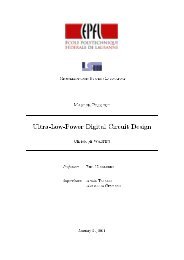Compressive Sensing system for recording of ECoG signals in-vivo
Compressive Sensing system for recording of ECoG signals in-vivo
Compressive Sensing system for recording of ECoG signals in-vivo
Create successful ePaper yourself
Turn your PDF publications into a flip-book with our unique Google optimized e-Paper software.
2.4.2. Sparsify<strong>in</strong>g basesSparsify<strong>in</strong>g basis have been used are identity basis <strong>for</strong> time-doma<strong>in</strong> sparse reconstruction whenthe <strong>signals</strong> which are recorded are already sparse <strong>in</strong> time-doma<strong>in</strong>. The <strong>in</strong>verse Fouriertrans<strong>for</strong>m has been used <strong>for</strong> frequency-doma<strong>in</strong> sparse reconstruction [1, 22]. The Gabor space[27] has been considered as sparsify<strong>in</strong>g basis <strong>for</strong> EEG <strong>signals</strong> which are assumed to becomposed by short s<strong>in</strong>usoidal bursts. In the same way, wavelet-doma<strong>in</strong> basis area good basischoice <strong>for</strong> EEG and <strong>ECoG</strong> <strong>signals</strong> which are considered as w<strong>in</strong>dowed, piece-wise smoothpolynomials with additive noise [34, 35, 36].Figure 2.4.2.1. Tree structure <strong>of</strong> 3-level decomposed wavelet coefficients.More concretely, <strong>in</strong> the case <strong>of</strong> wavelet basis, the wavelets use a multi-scale decomposition, i.e.the coefficients <strong>of</strong> the wavelet trans<strong>for</strong>m are generated <strong>in</strong> a hierarchical manner us<strong>in</strong>g scaledependentlow pass, h(n), and high pass, g(n), filter impulse responses. h(n) and g(n) arequadrature mirror filters, (see Fig.2.4.2.1), correspond<strong>in</strong>g to the type <strong>of</strong> wavelet used [1].In the present work, the sparsify<strong>in</strong>g basis which has been proposed <strong>for</strong> futures <strong>system</strong>improvements is the one based on Daubechies wavelets. Two important po<strong>in</strong>ts have to beconsidered <strong>in</strong> order to create the WL basis: a) The number <strong>of</strong> samples and measurements arerecommended to be multiple <strong>of</strong> two, <strong>in</strong> order to construct a sparsify<strong>in</strong>g basis whose coefficientspropagation (see Fig.2.4.2.1) perfectly fit with these dimensions; b) the number <strong>of</strong> WLcoefficients has to be selected regard<strong>in</strong>g to the number <strong>of</strong> samples <strong>of</strong> the <strong>in</strong>put signal, <strong>in</strong> anycase the sparsify<strong>in</strong>g basis can be less sparse than the <strong>in</strong>put signal; and c) <strong>in</strong> the operationshows <strong>in</strong> Fig.2.4.1.1, the basis has to be the <strong>in</strong>verse trans<strong>for</strong>mation, <strong>in</strong> order to respect.2.5. Reconstruction MethodsCompressed <strong>signals</strong> can subsequently be recovered by us<strong>in</strong>g a greedy algorithm or a l<strong>in</strong>earprogram that determ<strong>in</strong>es the sparsest representation consistent with the acquiredmeasurements. The quality <strong>of</strong> the reconstruction depends on: a) compressibility <strong>of</strong> the signal; b)choice <strong>of</strong> the reconstruction algorithm; and c) <strong>in</strong>coherence between the measurement matrixand the sparsify<strong>in</strong>g basis.35















